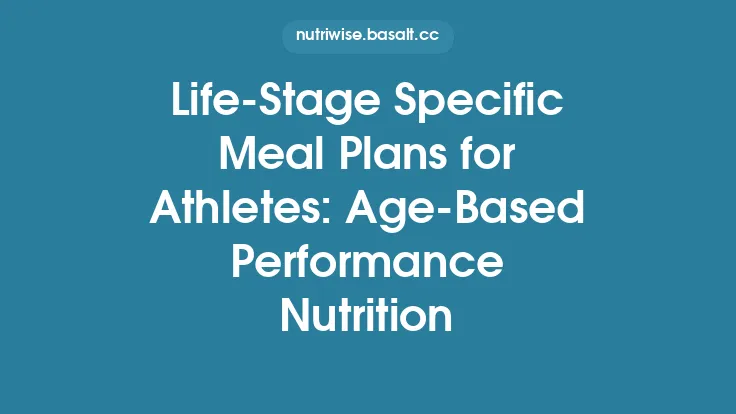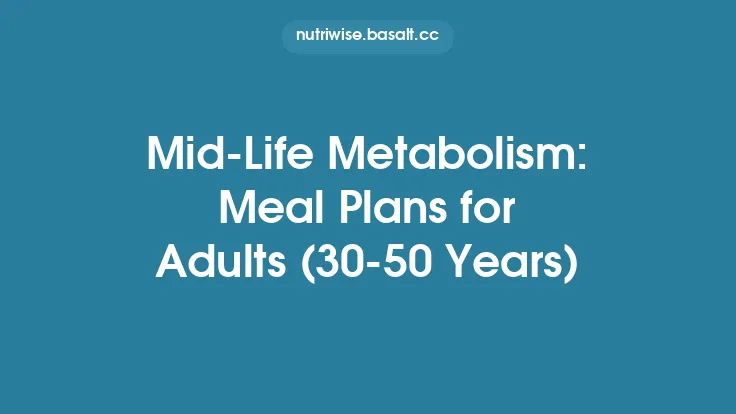Breastfeeding is a demanding physiological process that can feel both rewarding and exhausting, especially in the weeks and months after birth. While the baby’s needs often take center stage, the nursing mother’s nutrition plays a pivotal role in sustaining milk supply, supporting recovery from childbirth, and maintaining overall health. A well‑structured post‑birth meal plan doesn’t have to be complicated; it simply needs to provide enough calories, balanced macronutrients, and a rich array of micronutrients to meet the heightened demands of lactation. Below is a comprehensive guide that walks you through the science behind lactation nutrition, offers practical meal‑planning strategies, and provides sample menus that can be adapted to a variety of lifestyles and dietary preferences.
Why Nutrition Matters During Lactation
- Energy Expenditure
Producing breast milk burns roughly 500 kcal per day for an average‑sized infant. This figure can rise to 600–700 kcal for twins or larger babies. Without adequate caloric intake, mothers may experience fatigue, weight loss, or a decline in milk volume.
- Nutrient Transfer
While the composition of breast milk is tightly regulated, certain nutrients—particularly water‑soluble vitamins and some minerals—are directly influenced by maternal stores. Deficiencies in the mother can lead to lower concentrations of these nutrients in the milk, potentially affecting the infant’s growth and development.
- Maternal Recovery
Post‑partum healing, hormonal rebalancing, and the physical demands of caring for a newborn all require a robust nutritional foundation. Proper intake supports tissue repair, immune function, and mental well‑being.
Macronutrient Needs for Breastfeeding Moms
| Nutrient | Recommended Intake* | Primary Food Sources | Practical Tips |
|---|---|---|---|
| Calories | +300–500 kcal above pre‑pregnancy needs (≈2,200–2,500 kcal for most women) | Whole grains, starchy vegetables, nuts, dairy, lean proteins | Add a small “extra” snack (e.g., a banana with nut butter) between meals. |
| Protein | 1.1–1.3 g/kg body weight (≈70–100 g/day) | Poultry, fish, eggs, legumes, Greek yogurt, tofu | Aim for 20–30 g of protein per main meal; include a protein‑rich snack. |
| Fat | 20–35 % of total calories, with emphasis on omega‑3s | Fatty fish (salmon, sardines), flaxseed, chia, walnuts, avocado, olive oil | Incorporate at least two omega‑3 servings per week; use olive oil for cooking. |
| Carbohydrates | 45–65 % of total calories, focusing on complex carbs | Whole‑grain breads, brown rice, quinoa, oats, sweet potatoes, fruits | Pair carbs with protein/fat to stabilize blood sugar and sustain energy. |
\*These are general guidelines; individual needs may vary based on activity level, body composition, and metabolic factors.
Key Micronutrients and Their Food Sources
| Micronutrient | Why It’s Critical for Lactation | Recommended Daily Amount | Food Sources |
|---|---|---|---|
| Calcium | Supports bone health for both mother and infant; essential for milk calcium content. | 1,000 mg (1,200 mg if <19 y) | Low‑fat dairy, fortified plant milks, kale, almonds, tofu set with calcium. |
| Iron | Replenishes stores lost during delivery; prevents maternal anemia that can reduce milk supply. | 9 mg (post‑partum) | Lean red meat, poultry, lentils, spinach, iron‑fortified cereals; pair with vitamin C for better absorption. |
| Vitamin D | Facilitates calcium absorption; low levels linked to reduced milk calcium and maternal bone loss. | 600–800 IU (may need higher if deficient) | Fatty fish, fortified dairy/plant milks, egg yolk; consider safe sun exposure or supplementation. |
| Iodine | Crucial for infant thyroid function and neurodevelopment. | 290 µg | Iodized salt, seaweed (moderate), dairy, eggs. |
| B‑Vitamins (especially B12 & Folate) | Support energy metabolism and red blood cell formation. | B12: 2.8 µg; Folate: 500 µg (post‑partum) | Animal products (B12), fortified cereals, leafy greens, legumes (folate). |
| Zinc | Involved in milk synthesis and immune function. | 12 mg | Beef, pumpkin seeds, chickpeas, dairy. |
| Omega‑3 DHA | Enhances infant brain and eye development; may improve maternal mood. | 200–300 mg DHA | Salmon, sardines, herring, algae‑based supplements. |
Tip: A daily prenatal/post‑natal multivitamin that includes these micronutrients can serve as a safety net, especially during the early weeks when meal planning may be erratic.
Hydration Strategies
Breast milk is about 88 % water, so adequate fluid intake is non‑negotiable. While there is no universally fixed volume, most lactating women find that drinking ≈2.7 L (≈12 cups) of fluids per day meets their needs. Here are evidence‑based practices:
- Sip Consistently: Keep a water bottle within arm’s reach and take small sips throughout the day rather than large, infrequent gulps.
- Include Hydrating Foods: Cucumber, watermelon, oranges, and soups contribute to total fluid intake.
- Monitor Urine Color: Light straw‑yellow indicates proper hydration; darker urine suggests a need for more fluids.
- Limit Diuretics: Excessive caffeine (>300 mg/day) or high‑sugar sodas can increase urine output without providing nutritional benefits.
Sample 7‑Day Meal Plan
> Note: Portion sizes are adjustable based on individual calorie targets. The plan emphasizes whole foods, balanced macronutrients, and a variety of micronutrient sources.
Day 1
- Breakfast: Overnight oats made with rolled oats, fortified soy milk, chia seeds, sliced banana, and a drizzle of almond butter.
- Mid‑Morning Snack: Greek yogurt (plain) topped with mixed berries and a sprinkle of pumpkin seeds.
- Lunch: Quinoa salad with grilled chicken, roasted sweet potatoes, kale, avocado, and a lemon‑olive‑oil dressing.
- Afternoon Snack: Whole‑grain toast with hummus and carrot sticks.
- Dinner: Baked salmon (rich in DHA) with brown rice, steamed broccoli, and a side of mixed greens tossed in vinaigrette.
- Evening Snack (optional): Warm milk (dairy or fortified plant) with a dash of cinnamon.
Day 2
- Breakfast: Scrambled eggs with spinach, feta, and whole‑grain pita; a side of orange slices.
- Snack: Apple slices with peanut butter.
- Lunch: Lentil soup (iron‑rich) with a side of whole‑grain crackers and a small mixed‑leaf salad.
- Snack: Cottage cheese with pineapple chunks.
- Dinner: Stir‑fried tofu, bell peppers, snap peas, and carrots over soba noodles; topped with toasted sesame seeds.
- Evening Snack: A handful of walnuts.
*(Continue similarly for Days 3‑7, rotating protein sources (lean beef, turkey, beans), carbohydrate bases (sweet potatoes, barley, millet), and incorporating a variety of fruits and vegetables to cover the micronutrient spectrum.)*
Snack Ideas to Boost Milk Production
While the concept of “galactagogues” (foods that increase milk supply) is often debated, certain nutrient‑dense snacks can support overall lactation health:
- Oat‑Based Energy Balls – Oats provide beta‑glucan fiber, which may modestly enhance prolactin levels.
- Almond‑Butter Banana Wraps – Combines healthy fats, potassium, and protein.
- Greek Yogurt Parfait – Layered with granola, honey, and sliced kiwi (vitamin C for iron absorption).
- Edamame Pods – Plant‑based protein and calcium.
- Smoothie with Spinach, Pineapple, Greek Yogurt, and Flaxseed – Offers iron, vitamin C, calcium, and omega‑3s.
Meal Prep Tips for Busy New Parents
- Batch‑Cook Staples: Prepare large quantities of quinoa, brown rice, or whole‑grain pasta on the weekend; store in portioned containers for quick assembly.
- Pre‑Portion Snacks: Divide nuts, seeds, and dried fruit into single‑serve bags to grab on the go.
- Utilize the Freezer: Cook double batches of soups, stews, or casseroles; freeze in individual portions for reheating.
- One‑Pot Meals: Sheet‑pan roasted vegetables with protein, or slow‑cooker chili, reduce cleanup time.
- Leverage Convenience Items: Pre‑washed salad greens, pre‑cut veg, and canned beans (rinsed) can shave minutes off prep without sacrificing nutrition.
Common Myths and Evidence‑Based Clarifications
| Myth | Reality |
|---|---|
| “You must eat a lot of dairy to produce more milk.” | While calcium is essential, excessive dairy does not directly increase volume. Adequate calcium (≈1,000 mg) can be met through a variety of sources. |
| “Spicy foods will make the baby fussy.” | Most infants tolerate maternal dietary spices without issue. Some babies may react to certain flavors, but there is no consistent evidence that spice reduces milk supply. |
| “You need to drink gallons of water to boost supply.” | Over‑hydration does not increase milk production beyond normal physiological limits. Drinking to thirst and maintaining light‑colored urine is sufficient. |
| “Skipping meals helps you lose pregnancy weight faster.” | Undereating can lower milk output and deplete maternal nutrient stores. A modest caloric surplus is recommended for lactation. |
| “Herbal galactagogues like fenugreek are universally safe.” | Some herbs can cause gastrointestinal upset or interact with medications. Always consult a healthcare professional before starting supplements. |
Adapting Plans for Special Dietary Needs
- Vegetarian/Vegan: Emphasize plant proteins (lentils, tempeh, soy products), fortified plant milks for calcium and vitamin D, and algae‑derived DHA supplements. Pair iron‑rich legumes with vitamin C sources to enhance absorption.
- Gluten‑Free: Substitute wheat‑based grains with rice, quinoa, millet, or certified gluten‑free oats. Ensure processed gluten‑free breads are fortified with B‑vitamins and iron.
- Low‑Sodium: Use herbs, spices, citrus, and vinegar for flavor instead of salt. Choose fresh or low‑sodium canned vegetables.
- Allergy‑Sensitive (e.g., dairy, nuts): Replace dairy with fortified soy or oat milks; swap nuts for seeds (pumpkin, sunflower) or roasted chickpeas for crunch.
Monitoring Progress and When to Seek Professional Guidance
- Track Energy Levels & Mood: Persistent fatigue, irritability, or depressive symptoms may signal inadequate caloric or nutrient intake.
- Assess Milk Output: A noticeable decline in wet diapers or infant weight gain warrants a review of diet and hydration.
- Check Body Weight: Gradual weight loss of 0.5–1 lb per week is typical; rapid loss may indicate under‑eating.
- Laboratory Tests: If you suspect deficiencies (e.g., iron, vitamin D), a simple blood panel can guide supplementation.
- Consult Professionals: A registered dietitian specializing in lactation can personalize meal plans, while a lactation consultant can address supply concerns.
Final Thoughts
Nursing mothers have a unique set of nutritional demands that intersect with the practical realities of caring for a newborn. By focusing on adequate calories, balanced macronutrients, and a broad spectrum of micronutrients, you can support robust milk production, accelerate post‑partum recovery, and maintain your own health and vitality. The sample meal plan and practical strategies outlined above are designed to be flexible, allowing you to tailor them to your cultural preferences, dietary restrictions, and daily schedule. Remember that consistency—rather than perfection—is the cornerstone of successful lactation nutrition. When in doubt, reach out to a qualified health professional to fine‑tune your approach and ensure both you and your baby thrive.





